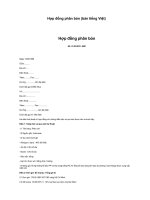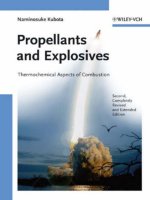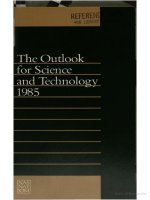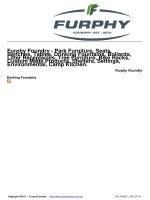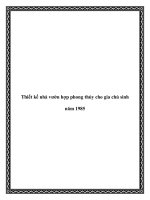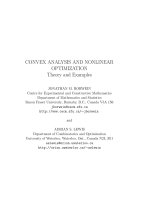lewis - kitchen improvised fertilizer explosives (infopub, 1985)
Bạn đang xem bản rút gọn của tài liệu. Xem và tải ngay bản đầy đủ của tài liệu tại đây (2.77 MB, 68 trang )
KITCHEN IMPROVISED
FERTILIZER EXPLOSIVES
By Tim Lewis
Scanned by NeXuS / ExCDiG InC.
COPYRIGHT 1985
INFORMATION PUBLISHING CO.
P.O. Box 10042
Odessa, Texas 79767-0042
All rights reserved!!!
Absolutely no part may be reproduced in
any manner or form without the express
written consent of the author and
Information Publishing Co.!!
TABLE OF CONTENTS
PRILLED FGAN - #2 FUEL OIL l
PRILLED FGAN - #2 FUEL OIL (Cap sensitive) 9
PRILLED FGAN - POWDERED COALOR CHARCOAL 11
PRILLED FGAN - GASOLINE 13
PR I L L E D FGAN - ANTIFREEZE 15
PRILLED FGAN - MAGNESIUM 17
P R I L L E D FGAN - NITROGLYCERIN 19
PRILLED FGAN - METHANOL OR ETHANOL 23
PRILLED FGAN - ALUMINUM 25
PRILLED FGAN - MONONITRONAPTHALENE 27
POWDERED FGAN - #2 FUEL OIL 31
POWDERED FGAN - ALUMINUM POWDER 33
POWDERED FGAN - DIETHYLENE GLYCOL (Antifreeze) 35
POWDERED FGAN -
HEXAMETHLYENETETRAMINE ADDUCT 37
POWDERED FGAN - NITROGLYCERIN 39
POWDERED FGAN - NITROMETHANE (Astrolite) 43
POWDERED FGAN - METALLIC NITRATE 45
POWDERED FGAN - RED PHOSPOROUS - COFFEE 47
FGAN-HEXAMINE-NITRIC ACID GELATIN 49
FGAN-HEXAMINE OR UREA GELATIN 51
FGAN-ANTIFREEZE-SMOKELESS POWDER GELATIN 55
FGAN-MONOMETHYLAMINE NITRATE GELATIN 57
FGAN-SLURRY COMPOSITION #1 59
FGAN-SLURRY COMPOSITION #2 61
FGAN-SLURRY COMPOSITION #3 63
FGAN-SLURRY COMPOSITION #4 65
CAST FGAN-WAX FOAMED CHARGE (Cap Sensitive) 67
CAST FGAN-FUEL OR CHNO EXPLOSIVE ("Ammonex") 71
CAST FGAN-MONOMETHYLAMINE NITRATE ("FORMIT") 73
FGAN-HYDRAZINE (HYDRAZINE NITRATE) 75
FOREWARD
The U.S. standard of living is falling slowly. At the bottom of this fall are
countries like Kenya and Pakistan. The youth of America is not interested in
bettering themselves and their country, but just in partying and having a good
time. What they don't realize is that this advancement of our culture is necessary.
Time after time I have heard them say, "But I CAN'T" There is not such thing as
can't. Instead what they mean is they won't. Quite a difference in my book. It
saddens me greatly to see this. 1 will partly put the blame on our educational
system. Of course, the American people should receive the bulk of the blame.
This should also be placed on the parents of Americans, as they let themselves
and their kids be brainwashed on T.V. I personally know I have never learned
anything of real value on T.V. that can't be thought of off hand. Every day we see
liberal programming on the "tube" with a one sided slant. I don't believe the
people should allow themselves to be brainwashed. With the advent of
subliminals and their use on T.V. (yes, they use them today on most commercials
contrary to popular belief) proves the desire of a few to control the populace.
Stupid people (brainwashed) or people sheltered from reality as in the
U.S.S.R. are the easiest to control. They can do this. Reams of government
research on the subject of control of minds have been carried out.
IT'S YOUR RESPONSIBILITY TO KNOW WHAT'S GOING ON, NOT
SOMEONE ELSE'S. YOUR M I N D IS YOURS TO ENJOY AND USE, NOT
FOR SOMEONE ELSE TO GET INSI DE OF AND CONTROL. THIS IS
THE WORST TYPE OF THEFT!!
WARNING!!!
The procedures in this book can be dangerous. The compounds produced in
these procedures are or can be dangerous. The actual manufacture of explosives
is illegal and classified as a felony. These processes are given as information and
information only! The actual use of this information by persons not familiar
with proper laboratory procedures and. safety can be dangerous if not fatal.
Students of explosives should obtain a good college level chemistry book and
laboratory procedure handbook. Reasonable care has been used in the
compilation of this book and this information has been presented for it's
educational value only. Due to the nature of these explosive compounds, neither
the publisher or the author can or will accept any responsibility for this
information and it's subsequent use. All responsibility is assumed by the
reader!!!!!!
PRILLED FGAN-#2 FUEL OIL (Diesel)
DETONATION RATE - 2,000-4,400 M/sec 6,550-14,410 Ft./sec.
DETONATION PRESSURE - 565,000, 900,000 P.S.I.
DENSITY OF LOADING - .98 to 1.2 G/cc.
.
Density is controlled by the
prills size and bulk density. Users need not worry, as this is already controlled for
them.
SENSITIVITY - requires a
1
/
4
to
1
/
2
stick of dynamite, 50-100 G. high explosive
(T.N.T., P.E.T.N., Picric acid, etc.), Detonating cord ("Primercord" or
equivalent), 200 G. of other cap sensitive AN explosive (powdered, foamed case,
red phosporous-AN, etc.). Shock sensitive to a 30 cm. drop of a 2 Kg. weight.
USE-
BLASTING - It's use is very versatile due to the very pourable nature of the
finished product. It must be used in large diameter bore holes (4 inches and
larger) that are dry. If wet bore holes are encountered, the charges can be loaded
in plastic containers (polyethylene bags or trash bags or equivalent). Good earth
mover and finds a great use as a ditching or earth-pond blasting.
DEMOLITIONS - It's use is limited. It can be used to blow foundations,
bridge and building substructures with below ground charge placement next to
the target.
MUNITIONS - Again it's use is limited as very heavy cases are required with
good charge containment. Fragmentation is 30-50% as good at T.N.T It will,
however, work in this role, but very large charges are required, as the the user
must count on the large long duration blast wave to kill by concussion alone as
fragment generation is considered poor. As a grenade filler, it will work, but
other explosives would be a better choice.
SAFETY PRECAUTIONS - Very stable, but should be made up as needed.
AN should be kept dry to ensure proper detonation. This explosive is a definite
fire hazard. Flame and heat should be avoided. Not shock sensitive as explosives
go, but can be detonated by a very sharp blow (30cm drop of a 2 Kg. weight will
detonate). Copper and brass should be avoided in manufacture and all
munitions loading and finished products.
Ammonium nitrate fuel oil explosives are without a doubt the most widely
used explosive on the face of the earth. It has gained this title by it's low price,
ease of on site manufacture and it's good blasting characteristics. Ease of
acquisition and relative high power, make this explosive very desirable to home
or calindistine manufacture. Being comparable to 40% dynamites, their blasting
efficiency can be considered the same for all practical purposes and charge
computation figures for 40% dynamite can be used to begin calculations.
To manufacture these ANFO (prilled) explosives, the procedure is very
simple. The AN prills are placed in a container. The proper amount of fuel oil or
diesel is added and the mixture is intimately mechanically mixed. For smaller
batches of the explosive, an empty, clean and dry coffee can may be used. The
mixing in this type of small batch is best done by hand by simply rolling the
explosive mixture on the floor after the plastic lid is firmly in place. This should
be done for fifteen to twenty minutes. Larger coffee cans may be used for slightly
larger batches. Clean and dry empty five gallon cans could be used to make even
larger batches with slightly longer mixing times. With large blasting operations
the ideal manufacture technique is to use a cement mixer. A small portable type
will work very satisfactorily. With these larger size batches, mixing times should
be increased to 1 hour. Another trick to obtaining a good stable standardized
explosive is to paint the outside of the cement mixer black. Since operations of
this magnitude will always be performed outside and on site, sunlight will heat
the mixture and promote the best dispersion of the fuel oil throughout the prilled
AN. Of course, all AN explosives should be kept dry and all containers and
mixing apparatus should be completely free of moisture and contact with the
atmosphere (humidity) should be avoided.
The mixture's proportions can vary somewhat with the desired purpose.
Lesser fuel percentages down to 1% total weight will give an explosive that is a
little easier to detonate and has the higher detonation rates. Mixtures with a fuel
concentration of over 5% will give more power and a greater heaving force and a
lower detonation rate, but require heavier boosters. Addition of 1-5% "Bullseye"
smokeless powder, give a composition of greater strength and more detonation
sensitivity and greater detonation rate than figures at the beginning of this
section. Also a .25-1% addition of "Tide" or "Mr. Bubble" soaps, as with other
AN explosives, will increase the performance of the finished explosive mixture.
The percentages by weight are as follows for ANFO (prilled) explosives:
AMMONIUM NITRATE (fert. grade) 94.5%
FUEL OIL or DIESEL 5.5%
This explosive is the best and safest of the blasting explosives! For all general
blasting work, dollar for dollar, it is the best explosive for 85% of all blasting
operations.
DETONATION VELOCITY
Confined - 4600 M/sec.
Unconfined = 3200-4600 M/sec.
DETONATION PRESSURE - 490,000-1,000,000 P.S.I.
SENSITIVITY - One #8 blasting cap will initiate detonation in charges larger
than 2.25 inches, but similar untreated prills will not detonate.
USE-
BLASTING - Useful in blasting due to the fact that it is easy and very
inexpensive to prepare. This prilled form of the usual ANFO explosives is
attractive to the blaster because in nearly all applications this type of prilled
ANFO explosive will have a higher detonation rate and therefore an increased
performance over it's counterpart.
DEMOLITION - See PRILLED AN-FUEL OIL
MUNITIONS - See PRILLED AN-FUEL OIL
This is a very interesting development of the ANFO explosives. While being
very simple, it effectively sensitizes the fertilizer grade of AN when mixed with
diesel, so that one blasting cap will detonate the resulting mix. It makes use of the
tendancy of even small amounts of water to effect the crystalline structure of the
prills in such a way that effective density is lowered. This, in conjunction with
available fuel, yields an explosive that is cap sensitive. This is one of the most
simple cap sensitive explosive compositions in this book.
This procedure really should be performed of all prilled AN explosives. This
lowers the actual density of the prills. Giving an optimum density for the proper
absorbtion of most ANFO. Compositions with 94.4% AN and 5.6% fuel oil are
considered optimum. These will also be cap sensitive. The fuels in the
compositions below are considered slightly higher than the AN FO explosive due
to sensitivity and performance respectively. Take 40 G. of ammonium nitrate
prills (fertilizer grade) and to them add 10 G. (lOcc) water. This mixture is heated
to 90 degrees C. (195 degrees F.). All of the prills should dissolve. If not stir the
liquid until they do. This liquid (saturated AN-water solution) is then added to a
mixture of 14 G. #2 diesel and 186 G. ammonium nitrate prills (fert. grade). This
mixture is stirred and poured into a suitable container (stainless steel pan) and
placed in an oven with the thermostat set at 150 degrees F. for 2.5 hours with
constant supervision. Ammonium nitrate when mixed with fuels are dangerous
when heated. Better and safer than this is to place these wetted prills in a
desicator (laboratory drier) or in a container with a vacuum drawn on it and it's
contents so as to remove the water. This vacuum method of water removal is best
and will yield the highest performance mixtures. In boiling water off the AN
prills under reduced pressure porous prills are produced by the water vapor
escape from inside the prills.
These prills will produce cap sensitive mixtures easily with almost any liquid
hydrocarbon. Fuel oil, naptha, gasoline, carbondfdisulfide and almost anything
liquid that will combust will work.
AMMONIUM NITRATE (Fert, prills) 40 G. or 14.6%
WATER 10.cc or 4.0%
AMMONIUM NITRATE (Fert, prills) 186 G. or 74.4%
GASOLINE 5 G. or 2.5%
WAX (PARIFFIN) 9 G. or 3.1%
or
DIESEL 7 G.
ALUMINUM POWDER (400 Mesh) . 14 G.
This procedure should work on other liquid fuels except the very volatile ones
such as gasoline and the alcohols giving easily prepared cap sensitive explosive
compositions. Also the substitution of 14 G. of powdered aluminum for 7 G. of
the diesel will give a slightly higher performance explosive.
Treated prills.Untreated prills.
PRILLED AN-POWDERED COAL OR CHARCOAL
DETONATION VELOCITY - 2400-3500 M/sec.
DETONATION PRESSURE - 390,000-800,000 P.S.I.
USE-
BLASTING - Limited to earth moving and other blasting operations where
high "heaving" value and not high velocity are the factors influencing explosive
choice. A very cheap easily manufactured blasting agent with a cost effectiveness
not easily surpassed in most bulk blasting operations.
DEMOLITIONS - Not a good choice due to the very low detonation rate and
relative bristance.
MUNITIONS - Not a good choice here either due to the low velocity and low
bristance or shattering power.
A good cheap blasting agent. This explosive should be limited to earth moving
applications and with a preference for the prilled AN-fuel oil explosive over this
explosive. In all, with easy acquisition of the sensitizer, this composition is one of
the better home concocted explosives for a blasting application. Coal or
charcoal is readily available and cheap. This explosive is manufactured by the
addition of the powdered charcoal to the prills and subsequent tumbling or
shaking to ensure an intimate mixing of the components. A major drawback of
this mixture is the tendancy for the charcoal and the AN to separate out due to
the different actual densities of the two ingredients. A small percentage (1-2%) of
fuel oil substituted for part of the charcoal, causes the charcoal to adhere to the
prills and virtually eliminate this problem. Actual composition of these
explosives are given below:
#1
PRILLED AN 94%
CHARCOAL (powdered dust) 6%
#2
PRILLED AN 94%
CHARCOAL (powdered dust) 5%
#2 FUEL OIL OR DIESEL 1%
Minimum charge diameter of the first formula should be around 8 inches.
Whereas the 2nd formulation can be used in bore holes 6 inches or greater in
diameter. Water and wet blasting condition should be avoided with the first
composition due to the lack of water tolerance. The 2nd explosive has a slightly
greater tolerance, but with all AN explosives, unless they are designed for wet
applications, water and wet conditions should be avoided.
PRILLED AN-GASOLINE
DETONATION RATE - 2700-4650 M/sec.
DETONATION PRESSURE - 190,000-1,100,000 P.S.I.
SENSITIVITY - Same as prilled An-Fuel oil. Perhaps slightly more sensitive,
but adequate boosters are required to ensure an efficient detonation.
USE-
BLASTING - Not suitable due to the volatility of the fuel sensitizer. Could be
used if the volatile nature were taken into account and steps taken to counter act
this fuel sensitizer loss due to evaporation. A powerful higher velocity explosive
as opposed to AN-fuel oil explosives. Also cost effective due to the ready access
and low cost of the sensitizer.
DEMOLITIONS - Not suitable due to the volatile nature and relative low
velocity of detonation. For more about usage, see prilled An-fuel oil explosive.
Volatility could be overcome to some extent if necessary by on site mixing and
immediate use!!
MUNITIONS - Unsuitable!!
This explosive is limited in use due to it's volatile nature. The gasoline will
evaporate with time, giving erratic performance and detonation sensitivity. It is
easier, however, to make than the prilled AN-fuel oil composition. The lower
density of the fuel makes for better penetration of the AN prills and also gives an
explosive of higher detonation velocity and consequently slightly higher actual
power. It is easily prepared by simply pouring the gasoline over the AN prills in a
container impervious to gasoline and tumbling until a homogeneous mixture is
obtained. As with the other prilled AN explosives, higher performance can be
obtained by the addition of .5 to 1% total explosive weight of sodium dodecyl
benzene sulfonate ("Tide", "Mr. Bubble" soaps or Connaco 50 detergent). The
explosive consists of the following mixture:
PRILLED AN . . . 94%
GASOLINE 6%
This explosives volatile nature can be overcome to some extent by enclosing
the mixed explosive composition in something impervious to gasoline. Large
trash bags would serve this purpose. The explosive would need to be used
quickly, however, as this measure would not be enough to ensure the explosives
loss of sensitizer to evaporation. Better explosive composition can be had, but
this one would work and is powerful!!
PRILLED FGAN-ANTIFREEZE
DETONATION RATE - 2700-4500 M/sec.
SENSITIVITY - See FGAN-Fuel oil.
USE-
BLASTING - Use is limited due to the high cost of the diethylene glycol
(antifreeze). It is also very hygroscopic. Good power and slightly greater
detonation rate than the FGAN-Fuel oil composition. Good for earth moving
and other similar uses. Cost effectiveness less than that of FGAN-Fuel oil.
DEMOLITIONS - See Prilled FGAN-Fuel oil.
MUNITIONS - Hygroscopic. See Prilled FGAN-Fuel oil.
A good explosive if the ethylene glycol or antifreeze is all the manufacturer has
available. It is slightly easier to detonate than the FGAN-Fuel oil composition
and has a greater detonation rate, all things being equal. Boosters would not
need to be quite as large as the FGAN-Fuel oil mixture would require. It is also
very hygroscopic and steps should be taken to ensure that the contamination of
the mixture with unwanted moisture is avoided.
This explosive is manufactured in essentially the same way as all the other
explosive compositions in this book so far. For details of these manufacture
techniques, see Prilled FGAN-Fuel Oil. The composition is as follows:
PRILLED FGAN 95.0%
DIETHYLENE GLYCOL (Antifreeze) . . . . . . . . . 5.0%
This glycol-AN explosive like the methanol and ethanol compositions are
very efficient. Since the glycols and glycerins are in effect forms of alcohols, they
perform similarly. Glycerin could be substituted for the glycol, but it's cost is
even higher than glycol. Addition of a small amount of "Tide" or "Mr. Bubble"
(e.g. sodium dodecyl benzene sulfonate) will increase the performance and
detonation rate by 15-35%.
PRILLED FGAN-MAGNESIUM
DETONATION RATE - 2600-4200 M/sec. 8536-13,790 Ft./sec.
DETONATION PRESSURE - 400,000-1,000,000 P.S.I.
SENSITIVITY - See Prilled FGAN-Aluminum.
USE-
BLASTING - See Prilled FGAN-Aluminum
DEMOLITIONS - See Prilled FGAN-Aluminum
MUNITIONS - See Prilled FGAN-Aluminum
This explosive composition is nearly identical to the Prilled FGAN-
Aluminum explosive. It is, however, a slightly more bristant, more powerful
explosive. This is due to the higher temperature of the combustion of the
magnesium powder as opposed to the aluminum powder. As with the FGAN-
Aluminum composition, this explosive gives an abnormal gas volume on
detonation. This will give this explosive a greater blast effect than most of the
explosives in the ammonium nitrate family. As with all good aluminum
containing explosives, they are oxygen deficient. This allows an after burning
effect. By this I mean the unreacted or oxidized fuel (Magnesium), preheated to
combustion temperature, is allowed to finish its combustion with the
atmospheric oxygen. This gives these explosives a high blast rate due to the long
pulse of positive pressure generated by the detonation. Aluminum is really
preferable to magnesium, due to its much lower cost. It will, however, on
detonation at night give a much brighter flash than will the aluminum. This is, of
course, due to the greater temperature of detonation, which causes a more
luminous candescence of the gases in the fireball. This boils down to a very
bright flash upon detonation in low light conditions. It should cause temporary
night blindness too!! Its composition is as follows:
PRILLED FGAN 80%
MAGNESIUM POWDER (300+mesh) 20%
PRILLED AN-NITROGLYCERIN
DETONATION RATE - 2800-4800 M/sec.
DETONATION PRESSURE - 450,000-1,000,000 P.S.I.
Depending on % of nitroglycerin
SENSITIVITY - This factor depends on the % of nitroglycerin. A 4%
composition requires a
1
/
4
stick of dynamite or equivalent. An 8-15%
composition requiring only a #6 blasting cap.
USE-
BLASTING - A good explosive for this purpose with a high bristance and
detonation rate. Very sensitive to the impulse from a reasonably small #6
detonator. However, this explosive due to the nature of the explosive sensitizer
would be limited to someone with prior chemistry experience. There is danger in
manufacture of this explosive!! While millions of gallons of nitroglycerin have
been manufactured since its introduction into the explosive field, home
manufacture by the unknowing, stupid, careless and suicidal WILL RESULT
MOST LIKELY IN DEATH!! This explosives manufacture should never be
undertaken unless the procedure is completely understood. THERE IS NO
ROOM FOR ERROR OR CARELESSNESS!!!! This explosive will, with
contact to the skin, cause the most tremendous migrain headache. Repeated and
continuous exposure to the skin and subsequent absorbtion will cause "nitro
heart" and possible future coronary problems and risks. Also contact with
detonation residues and gases will cause these same headaches and risks. The
powdered form of this explosive is a better choice as larger amounts of "nitro"
can be absorbed safely. For charge computation use 50% ammonia dynamite.
DEMOLITIONS - This explosive could be good for cratering charges, but is
not as cost effective as ANFO explosives. The powdered form of this explosive
would be a better choice, as it is more easily packaged and will hold a higher
percentage of "nitro".
MUNITION - The only munition this explosive would even be remotely good
for, would be some type of homemade fragmentation grenade.
First usage of this type explosive was made by the famous father of modern
explosives, Alfred Nobel. He purchased the patent from C.J. Ohlsson and J.H.
Norrbin in the early 1870's. This should give you some idea of how long these
explosives have been in use. They are powerful, primarily blasting explosives.
They have been supplemented in the modern explosives industry due to the cost
advantage of AN fuel oil explosives. These, however, are more powerful, due to
the higher heat of explosion which is a side effect of the "nitro" compounds
addition to the prilled ammonium nitrate. The "nitro" makes the explosive
resistant to water, which in some applications is advantageous. As the
nitroglycerin is added to the AN prills it forms a gel of AN and nitroglycerin on
the surface of the prill. This serves in the carrying of the shock wave generated by
the detonator throughout the explosive charge. This of course gives the
ammonium nitrate a higher detonation rate with only the addition of a small
amount of the high explosive sensitizer.
NITROGLYCERIN MANUFACTURE - The manufacture of nitroglycerin
is really a simple affair. The tendancy of nitroglycerin to explode from a shock (a
slight jar), heat (overheating of the acids during manufacture) and decompose
(explosively) from impurities make the manufacture a testing one. It can be done
with a good deal of safety by eliminating as many of the above problems in
manufacture. Only reagent or U.S.P. grade chemicals should be used. This will
eliminate the possibility of explosive decomposition from impurities. The
explosive oils sensitivity to shock can be reduced by careful control of the
temperature and avoiding bumps and jars of the containers during the
"nitration" process. The process below will not give as good a yield as the process
in "KITCHEN IMPROVISED PLASTIC EXPLOSIVES". It is, however, in
my opinion, a simple relatively safe process for the person not inept in chemistry
and laboratory processes.
CAUTION: Eye protection and viton gloves and apron should be worn during
this lab type process. Hash facilities (a shower) should be quickly accessable.
This process should be done in a well ventilated area!!
Take 100 ml. (CC) of nitric acid (specific Gravity 1.42, 70%, obtained from a
chemical lab. supply house) and place in a 1 pint fruit canning jar. 150 m. (CC) of
sulfuric acid (specific gravity 1.8, 98% / obtained from janitorial supply) is then
slowly poured into the nitric acid. This acid mixture will become hot when this
addition takes place. This container should be placed in a bath of salted ice
water. Care should be taken to ensure that none of the water gets into the acid
mixture. That would cause spattering of the hot acid mixture and big problems
for the person with the acid shower. A thermometer is placed into the mixed
acids. The temperature of the mixed acid should be allowed to drop to 0 degrees
C. (32 degrees F.). While the acids cool, place 80 ml. (CC) anhydrous glycerin in
a measuring cup. This cup should be placed in the freezing compartment of a
refrigerator or cooled in someway taking care to ensure water is not absorbed by
the glycerin. A quart canning jar is then filled to
1
/
2
its volume of crushed ice and
clear clean cold water. When the acids are at 0 degrees and the glycerin is as thick
as cold molasses or "Karo" syrup, the glycerin is slowly poured in to the acid
mixture in a manner that it floats on top of the cold mixed acids.
CAUTION: If at any time red fumes begin to issue from the acid-glycerin
combination, pour immediately with a gloved hand into the water and cracked
ice previously prepared!!!!!!!
With a teflon stirrer carefully stir the mixed acid and glycerin combination
TAKING GREAT CARE NOT TO CONTACT THE SIDES OR BOTTOM
OF THE CONTAINER!!! This stirring should be done vigorously and carefully
for 15 seconds and the whole mixture then immediately poured in to the cracked
ice. The nitroglycerin will fall out as a whitish oil in the bottom of the container.
Care should be taken to avoid bumping the lip of the jar with anything and the
container kept completely free of shocks and bumps. The acid-water is then
poured off the nitroglycerin oil in the bottom of the container. Cold water is then
added to the "nitro" in the bottom of the quart canning jar. The liquids are
carefully swirled and as much water poured off as possible. This washing is
carried out one more time with the excess water being poured off. The resulting
oil and small amount of water is then treated with small amounts of sodium
bicarbonate (baking soda). The soda at first will effervesce (fizz). These
additions should be made until the effervescent reaction ceases with new small
additions of soda. The remaining water can then be removed with a syringe
carefully. Care should be taken not to bump the bottom of the container with the
syringe. The nitroglycerin should now be incorporated into the explosive.
ADDITION OF 25% ACETONE TO THIS EXPLOSIVE OIL WILL
RENDER IT MUCH LESS SENSITIVE TO SHOCK AND IS ADVISED!!!
To manufacture this explosive simply add the nitroglycerin to the AN prills
with gentle kneading with gloved hands (dishwasher gloves will work, but
should be discarded afterwards). The charcoal or other ingredient is added to the
AN before this nitro addition if desired. This addition will give a more powerful
explosive and is very desirable. If explosive is to be used immediately, the
addition of the fuel will not be necessary as the acetone will serve this purpose.
Below several compositions are given:
#1
PRILLED AN 88%
ONE OF THE FOLLOWING: CHARCOAL, DIESEL OIL
ANTIFREEZE, SULFUR, MOTOR OIL . . . 7%
NITROGLYCERIN 5%
#2
PRILLED AN . . . 83%
ALUMINUM OR MAGNESIUM POWDER (400 MESH) 10%
NITROGLYCERIN 7%
#3
PRILLED AN
79%
FUEL (ONE FROM COMPOSITION #1) 6%
NITROGLYCERIN 15%
#4
PRILLED AN 72%
ALUMINUM OR MAGNESIUM POWDER (400 MESH) 13%
NITROGLYCERIN 15%
These explosives should be safe and very powerful for the compositions
containing higher percentages of nitroglycerin. The last two explosive formulas
will be the most easily detonated by a blasting cap. The last two will not need
confinement to achieve a good explosion, but the first formulations are
primarily for blasting purposes. The compositions containing aluminum should
have nitroglycerin additive containing as little water as possible which will give a
better performance and longer storage life.
PRILLED FGAN-METHANOL OR ETHANOL
DETONATION RATE - 2800-4500 M/sec. 9193-14775 Ft./sec.
SENSITIVITY - Same as prilled FGAN-#2 fuel oil.
USE-
BLASTING - Practically the same as prilled FGAN-#2 fuel oil. This explosive
is less water tolerant as the FGAN-FO mixture. It also has a slightly higher
detonation rate for all practical purposes. But has a higher cost due to the
increased cost of the sensitizer.
DEMOLITIONS - See Prilled FGAN-Fuel Oil.
MUNITIONS - Not desirable due to the very volatile nature of the sensitizer.
For performance see Prilled FGAN-Fuel oil.
This explosive is a good explosive, but the tendancy of the sensitizer to
evaporate before the charge is ready for detonation is a major problem. This can
be over come by sealing the prepared charges in an impervious container to
avoid this evaporation. It also has a characteristic of being very hygroscopic,
which is the tendancy to take water from the air which makes detonation more
difficult. It is, however, a good powerful explosive composition. Its higher
detonation rate over the AN-fuel oil composition is a definite plus. The figures
above do not really reflect this however. This greater detonation rate is realized
in charges that are not so well confined. An explanation of this is the less viscous
(thick) shorter simpler molecule is more easily transformed under the impulse of
the detonation wave as it moves through the explosive triggering the rapid
transformation from solid to gaseous state.
This explosive is more quickly manufactured due to the less dense fuel
sensitizer. This gives a more rapid and uniform absorbtion into the fertilizer
prills. The manufacture is accomplished by placing the proper amount of AN
prills in a container. Addition of the proper ratio of alcohol is the next step.
These are stirred or tumbled together until a complete uniform mixture is
obtained. The percentages are as follows:
PRILLED FGAN 94%
METHANOL or ETHANOL ALCOHOL 6%
This explosive is, as we stated earlier, sensitive of moisture and this should be
avoided in any storage or usage. One advantage of this explosive is the fact that it
produces very modest amounts of harmful gaseous detonation products, this
explosive would be the explosive of choice if usage in a semi-confined area where
work would need to commence right after the shot is fired! It is not permissable
in a coal mine due to the heat and longer period of high detonation product heat.
This can be overcome by the following composition:
PRILLED FGAN 82.5%
METHANOL or ETHANOL ALCOHOL 7.5%
SODIUM CHLORIDE (table salt) 10.0%
This deviation from the composition above above, gives the explosive an
excess of fuel which lowers the flame temperature and the sodium chloride
further cools the flame temperature. This composition will give a higher
percentage of carbon dioxide in the gaseous products yield, but you can't have
your cake and eat it too!!!
AMMONIUM NITRATE-ALUMINUM EXPLOSIVE
DETONATION RATE - 2600-3700 M/sec.
DETONATION PRESSURE - 650,000-1,320,000 P.S.I.
SENSITIVITY - Same as Prilled FGAN-#2 fuel oil explosive
USE-
BLASTING - Its use in blasting is limited due to the increased cost of the
aluminum component which drives up the cost per c u / f t earth moved. It is,
however, better at most tasks than AN-FO explosives. It has a definite potential
in blasting very hard rock and in usages where the bore holes are time consuming
to prepare. For charge computation, a reduction of 20% in total charge weight
can be utilized from FGAN-Fuel oil explosives.
DEMOLITIONS - Surpassed by the powdered AN-AL explosives and other
explosive formulations in this book. Best used in below ground usage although
in a thin case (6 inch and greater diameter pipe having a thick wall) it can find
above ground demolition use. Another interesting use would be in large scale
(washtub sized) shaped charges. Most targets could be defeated easily with the
exceptions of thick steel or armor plate and very heavily reinforced concrete
using 200 Ib. charges with good tamping (surrounding explosive on all sides with
the exception of the side of the charge facing the target) and with the correct
stand-off distance (distance from target to the face of the explosive). Multipoint
detonation would be a must for maximum efficiency.
MUNITIONS - This explosive should be a relatively good choice for loading
larger munitions. While none of the ammonium nitrate explosives with the
exception of some case AN explosives, some pressed AN explosives and AN
explosive containing CHNO explosives are very good choices for munitions this
could be used and as a concussion munitions filler. A fifty five gallon drum filled
with this explosive should produce blast overpressures in excess of 1000 P.S.I
This should kill in excess of a 300 meter radius of the point of detonation if laced
with detonation cord which would raise the detonation rate of the entire charge.
It would also be audible for 5 to 10 miles depending on the conditions existing at
the time of detonation (i.e atmospheric/ temperature inversion etc.).
This explosive is another composition utilizing the AN in the prilled fertilizer
grade. It is a powerful explosive utilizing the great heat of the transformation ot
aluminum into its oxidized state. Most people have heard of "Thermite" and the
same oxidation which generates the 4000 degree heat in thermite give this
ammonium nitrate explosive its greater power and blast coefficient. Ideally
these explosives should be mixed with a 20% negative oxygen balance to ensure
the afterburning affect of the aluminum powder in the air. This will lengthen the
pressure pulse created by detonation. Its manufacture is simple. Prilled
ammonium nitrate (fertilizer grade) and aluminum (preferably fine powdered
e.g. black German "pyro"grade) are mixed together in a suitable container in the
following proportions:
AMMONIUM NITRATE (fertilizer grade 32%+ nitrogen) 82%
ALUMINUM POWDER (200 mesh or greater) 18%
The aluminum powder used ideally should be of a flaked grade (paint grade)
which is cheaper than the "black" pyro grade and even the atomized will work
well. A lower performance but workable substitution could be made for part of
the aluminum powder with small chips (oilfree) of aluminum as produced in a
machine shop in turning or bandsawing operations. These components are
mixed in a clean dry container. The mixing should be carried out until an
intimate mixture is obtained. The different densities of the two components will
make this mixing difficult, so the addition of 1% total weight of diesel oil will
cause tha aluminum to stick to the granules of ammonium nitrate and raise
charge sensitivity. This fuel oil addition will also make the mixture propagate
detonation a little better. This explosive composition should be kept dry and free
from moisture, as moisture in this composite explosive will start an almost
immediate but slow break down yielding hydrogen as a by product. This
presence of moisture will also make the explosive difficult, if not impossible to
detonate without the use of a very heavy booster charge or charges. One last
note, as with the FG AN-FO explosives, this explosives' properties are improved
up to 30% by the addition of .5 to 1% "Tide" or "Mr. Bubble" or any detergent
containing Sodium dodecyl benzenesulfonate.
(L) Atomized aluminum powder
(R) German flake aluminum powder
